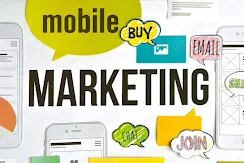- What is Mobile Marketing ?
- How Mobile Marketing Works ?
- Types of Mobile Marketing
- 7 Ms of Mobile Marketing
- Mobile Marketing Tools
- Characteristics of Mobile Marketing
- Advantages of Mobile Marketing
- Disadvantages of Mobile Marketing
- Cost of Mobile Marketing
- How to Start Mobile Marketing ?
- Mobile Marketing vs. Traditional Marketing
What is Mobile Marketing ?
How Mobile Marketing Works ?
Types of Mobile Marketing
What are the 7 Ms of Mobile Marketing ?
- Understanding the different types of mobile devices and their capabilities.
- Designing content that's compatible with various screen sizes and device specifications.
- Identifying and utilizing the platforms that users engage with on their mobile devices, such as apps and mobile websites.
- Choosing the appropriate platforms for your target audience.
- Considering the types of media that are effective on mobile devices, such as images, videos, and interactive content.
- Optimizing media for mobile consumption.
- Measuring and analyzing metrics specific to mobile marketing efforts, such as click-through rates, engagement rates, and app downloads.
- Using these metrics to assess the effectiveness of campaigns and make improvements.
- Recognizing the unique opportunities to engage with users during their "mobile moments" when they are actively using their devices.
- Crafting messages that align with these moments to capture attention and drive action.
- Identifying what motivates users to take action on their mobile devices.
- Creating content and offers that resonate with users' motivations.
- Developing concise and compelling messages that are suitable for mobile consumption.
- Crafting messages that are easy to understand and have clear calls-to-action.
What is Mobile Marketing Tools ?
What are the Characteristics of Mobile Marketing ?
Advantages of Mobile Marketing
Disadvantages of Mobile Marketing
How Much Does Mobile Marketing Cost ?
How to Start Mobile Marketing ?
Mobile Marketing vs. Traditional Marketing
|
|
Mobile Marketing |
Traditional Marketing |
|
Reach and Accessibility |
Mobile marketing leverages the widespread use of smartphones and
other mobile devices. It allows businesses to reach their audience anytime,
anywhere, as long as the audience has a mobile device and internet
connectivity. |
Traditional marketing involves mediums such as television, radio,
print media (newspapers, magazines), billboards, and direct mail. While these
methods can have wide reach, they are limited by physical locations and
scheduled air times. |
|
Targeting |
Mobile marketing can utilize data-driven targeting based on factors
like user demographics, location, behavior, and interests. This enables more
precise and personalized messaging. |
Traditional marketing methods generally have less granular targeting
options compared to mobile marketing. For instance, a TV ad might reach a
broad audience, but not everyone watching may be the target demographic. |
|
Interactivity and Engagement |
Mobile marketing can offer higher interactivity through methods like
mobile apps, in-app advertisements, interactive social media content, and
mobile games. This can lead to increased engagement and better two-way
communication with the audience. |
Traditional marketing methods usually have limited interactivity. For
example, TV and radio ads are passive forms of communication, with limited
ability for immediate interaction. |
|
Cost |
Mobile marketing can be cost-effective, especially for small
businesses, due to the ability to target specific audiences and control
budgets. However, costs can increase depending on the complexity of mobile
app development or advertising campaigns. |
Traditional marketing methods like TV or print ads can be more
expensive due to production costs and media placement fees. Small businesses
might find it challenging to compete in these spaces. |
|
Measurement and Analytics |
Mobile marketing provides more detailed analytics, such as
click-through rates, conversion rates, app installs, and user engagement
metrics. This allows marketers to optimize campaigns in real time. |
Traditional marketing can lack the immediate feedback and metrics
provided by digital channels, making it harder to measure the direct impact
of a campaign. |
|
Flexibility and Speed |
Mobile marketing campaigns can be launched quickly and adjusted in real-time
based on data insights and audience behavior. |
Traditional marketing campaigns often require longer lead times for
production and distribution, making quick adjustments more difficult. |
